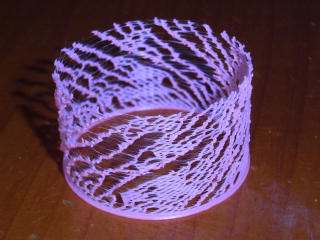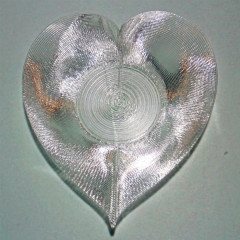Kanada, Y., 8th International Workshop on Natural Computing (IWNC 2014), 2014-3.
[ 日本語のページ ]
[ Slides ]
[ Book ]
[ Printing process (YouTube) ]
 Abstract: Fused deposition modeling (FDM) is a 3D-printing method that shapes 3D objects by layering melted plastic filament. The process of this type of 3D printing can be regarded as asynchronous cellular-automata because it generates 1D on-off pattern per a head motion. Especially, by a constant head-motion at reduced constant extrusion-velocity, a 3D printer can generate self-organized grids or similar structures, which is much finer than artificial (i.e., program-controlled) patterns. Depending on the parameter values, i.e., layer depth, extrusion velocity, and so on, the generated pattern varies among regular stripes, stripes with crossing waves, and splitting and merging patterns. Some of the patterns can be simulated by a computational model, i.e., asynchronous cellular automata.
Abstract: Fused deposition modeling (FDM) is a 3D-printing method that shapes 3D objects by layering melted plastic filament. The process of this type of 3D printing can be regarded as asynchronous cellular-automata because it generates 1D on-off pattern per a head motion. Especially, by a constant head-motion at reduced constant extrusion-velocity, a 3D printer can generate self-organized grids or similar structures, which is much finer than artificial (i.e., program-controlled) patterns. Depending on the parameter values, i.e., layer depth, extrusion velocity, and so on, the generated pattern varies among regular stripes, stripes with crossing waves, and splitting and merging patterns. Some of the patterns can be simulated by a computational model, i.e., asynchronous cellular automata.
Introduction to this research theme: 3D shape formation technologies
